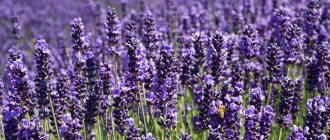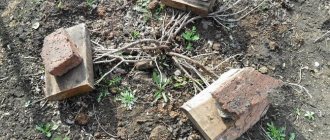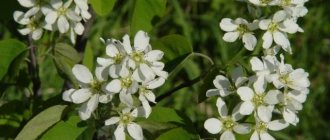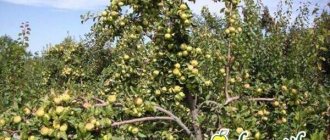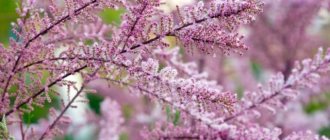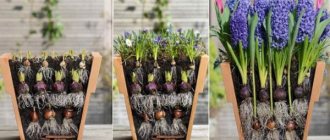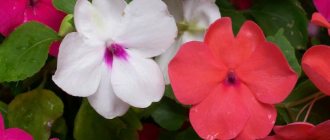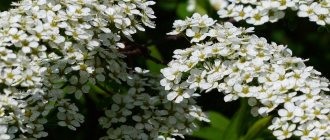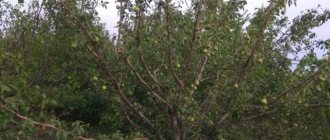Description
Bobovnik is a genus of deciduous shrubs or small, low-branched trees that belongs to the Legume family. The second name of this plant is laburnum. The genus Bobovnik contains 4 species, found in their natural habitat in Asia Minor, as well as southern and central Europe.
In culture, the boundaries of the shrub's distribution have expanded significantly: it is grown in many regions with warm climates. Moreover, they have been doing this for a long time, since 1560.
Bobovnik, aka “Golden Rain”
A perennial plant with trifoliate leaves and a cascade of spectacular racemes consisting of golden-yellow flowers, can be found in the Caucasus, Crimea, Central Asian countries and Ukraine. The ornamental shrub has been successfully acclimatized in the Southern Hemisphere, namely in Australia and New Zealand, where it grows and blooms well in garden areas.
This plant came to Russia at the beginning of the 19th century. Initially, the perennial shrub began to be grown in the Caucasus, and from there it spread further, gradually moving to more northern regions.
Today, the beautifully flowering plant can be found in parks and botanical gardens over a vast territory: from Sakhalin in the east to Kaliningrad in the west, and in the north of the country to St. Petersburg.
Plant leaves
The leaves of Bobovnik are decorative, and the bush can be used to create a hedge. However, the bean tree becomes most attractive during flowering, when small yellow flowers, similar in shape to moths, appear in abundance on its flexible branches.
Flowers collected in lush brushes up to 40 cm long, seem to flow between the branches of the plant, creating the impression of golden rain. Because of this attractive feature, the shrub has been given the name “golden shower”, and most often in everyday life many amateur gardeners call it that way.
bean flowers
In the wild, bean grows as a tree up to 10 meters high or a bush with straight main trunks and flexible hanging shoots. In the middle zone, the height of the bush is much lower: the bean grows up to 3 meters.
The bark of the plant trunks has a grayish-green or light brown tint. Young shoots of the bush are pubescent. The leaves are small, up to 5-7 cm long. They are smooth on the upper side, and pubescent below and have a silver-green color.
Small yellow flowers with a diameter of 2 cm are collected in gracefully hanging racemes.
The flowering period coincides with the appearance of leaves and lasts 15-20 days. After flowering, fruits ripen on the branches of the bush, having the appearance of pubescent beans up to 8 cm long with two valves and a pointed tip.
Types of shrubs
Alpine bean is quite rare and grows in the middle zone. Has the following characteristics:
- photophilous;
- most frost-hardy compared to other species (down to -28°C);
- height ranges from 0.5 to 3 m
- the cascading inflorescences are very narrow and long (up to 0.4 m).
Due to its similarity to the weeping willow, the alpine bean plant Gold Rhine is also called the “sunny waterfall”. It grows in mountainous areas such as Germany and Switzerland.
Anagyroleaf bean is the most common species, distinguished by:
- compact growth (2 – 3 m; rarely – up to 7 m);
- light brown branches resembling vines;
- leaves smooth on top and covered with down below;
- the earliest history of cultivation: the variety was bred back in the 16th century.
Because of the beautiful, flowing golden inflorescences, it received a second name - “Golden Rain”.
Interesting: the alkaloid cytisine, obtained from the angyroleaf bean plant, has been widely used in the treatment of vascular diseases of the eyes, heart and brain and, paradoxically, severe forms of intoxication.
Also, the plant extract can increase blood pressure and is used in the treatment of atherosclerosis, hypertension and internal bleeding, and the drug Cititon based on it is used as an anesthetic. Although in high doses it can cause severe poisoning and even paralysis of the nervous system.
Precautionary measures
All parts of the bean plant are poisonous because they contain the alkaloids laburnine and cytisine in high concentrations. The seeds of the plant are the most poisonous.
For this reason, the bush is dangerous to humans. Poisoning by the plant entails a disorder of the central nervous system, impaired breathing, heart function, nausea, convulsions and other serious consequences for the body, including a threat to life.
Behind the external beauty of the bean tree lies a danger - the plant is poisonous
Just two eaten seeds can lead to this result. Therefore, if this shrub grows on your site, it is necessary to limit access to the plant for children and pets. Any work with beans, including cuttings and transplanting young seedlings, should be carried out exclusively with gardening gloves.
Despite the fact that the bean plant is poisonous, it is successfully pollinated by insects. Moreover, this shrub is a good honey plant. The lifespan of the plant is about 20 years. Bobovnik is quite resistant to air pollution and can grow in unfavorable conditions and with little smoke.
Bobovnik (Laburnum) planting and care in the Moscow region propagation
The legume (laburnum) is a member of the legume family, but it looks like a deciduous tree. Laburnum is native to central Europe and the Mediterranean coast. The cultivated form of the tree is usually called garden bean. It should be noted that this is not a type of culture, but just its popular name.
General information
The main difference between laburnum and other decorative tree crops is the large inflorescences of yellow, pink, lilac and white, collected in hanging clusters. The brushes reach up to 50 centimeters in length and when flowering they emit a very pleasant aroma, similar to acacia.
If you properly care for the crop, it will delight the gardener with abundant flowering, the period of which will occur at the end of May and lasts until the end of June. When the bean flower fades, fruits in the form of small pods with beans begin to set in place of the inflorescences, thanks to which the tree can reproduce by self-sowing.
Growing this amazing crop is quite simple, the main thing is to take into account all the advice of experienced gardeners and an exotic bean plant will definitely appear on your site, which will delight you with its lush flowering, filling the air with an extraordinary aroma.
Bean varieties and types
Bobovnik Golden Rain - can be represented either by a compact bush or by a tree up to 6 meters in height. It has large light green three-fingered leaf blades. Laburnum begins to bloom at the end of May and ends in mid-June. The inflorescences are in the form of long yellow clusters that emit a pleasant aroma.
Bobovnik Anagyrofolia - in the wild, the tree grows in mountainous areas. Its height can reach up to 6 meters. The inflorescences are large, long, racemose, golden in color and have a delicate, acacia-like aroma.
Flowering time lasts from late spring to early summer. The leaf blades of this bean variety are medium in size, slightly pubescent below and have a dark green tint. The tree is winter-hardy and tolerates temperatures down to minus 20 degrees.
Alpine bean - in nature the tree grows up to 12 meters in height. It has a bush-like crown and large, light green trifoliate leaf blades.
Laburnum has large, long racemose inflorescences of bright yellow color, reminiscent of acacia. This bean variety is frost-resistant, although in cold winters the branches of the tree may freeze.
Therefore it needs shelter.
Common bean is a perennial deciduous tree with a spreading oval crown and a height of up to 7 meters. Often the bean tree has several trunks.
The trifoliate leaf blades are oval in shape and light green in color, which darkens with the onset of summer.
The bean blooms from May to June, with large long inflorescences of golden, pink, white or lilac hue.
Bobovnik Pink
It is a shrub with a compact crown. It has trifoliate oval leaf blades of a green hue. The tree blooms in spring for two weeks. It has large, long, racemose bright pink inflorescences with a delicate pleasant aroma and extraordinary decorative value.
Lilac bobovnik is a tree reaching a height of 2 meters with a spreading, loose crown and several trunks. The leaf blades of the bean are trifoliate with slight pubescence on the inside, light green in color.
Laburnum blooms from late spring to early summer. The inflorescences of the tree are racemose and reach a length of 30 centimeters. They have a rich purple hue and a pleasant aroma, vaguely reminiscent of acacia.
Alpine bean plant Gold Rhine - grows naturally in the mountainous areas of Switzerland and Germany. Laburnum reaches ten meters and looks like a bush-like tree with an elongated crown.
In Russia, since the plant often freezes, it has the shape of a bush and will grow only up to 3 meters. The leaf blades of the tree are long, trifoliate, smooth, and light green in color.
The bean inflorescences are large, racemose, long and bright yellow.
Waterer's bean - the tree is a hybrid of anagyrofolia and alpine bean. It reaches a height of 1 to 3 meters. The leaves are large, long, trifoliate and light green in color.
The bean tree blooms from late spring to early summer. Its inflorescences are bright yellow and racemose in shape. They also have extraordinary decorative characteristics and an intense, pleasant aroma.
Bobovnik planting and care in the Moscow region
Bean is a crop for which the choice of planting site is not too critical, so it can be planted anywhere in the garden. To plant a shrub, you should choose a lighted place, since due to a lack of light, the crop will stop growing and developing, and flowers will stop appearing on it, or there will be very few of them, and the inflorescences will lose their brightness.
Bobovnik can grow on depleted limestone, so there is no need to frequently fertilize during the growing season. To plant shrubs, it is better to choose a place protected from drafts and wind. Since the tree's root system does not tolerate stagnant moisture, the soil must be loose and well-drained.
To plant a bean tree, you should select several seedlings at once. Together, it will be easier for them to endure the winter, and their massive flowering will create a picture in the garden of simply extraordinary beauty.
Young trees need to be planted in early spring, when the snow has melted and the ground has warmed up well. For planting, you should prepare a planting hole in advance by digging it to a depth of 50 centimeters.
At its bottom it is necessary to pour a layer of expanded clay, fresh humus and lime. The bush should then be placed in the hole along with a support to which it should be tied.
This is necessary so that the young tree does not break under strong gusts of wind.
After it is placed in the planting hole, it is covered with garden soil, and the space around the trunk is mulched with a thick layer of a mixture of bark, sawdust, moss, straw and peat. When mulching is complete, the tree needs to be watered and the soil lightly compacted.
Purple or Cercis is also a member of the Legume family. It can be grown when planted and cared for in open ground without much hassle, if you follow the rules of agricultural technology. You can find all the necessary recommendations in this article.
Watering the bean tree
Since laburnum is a drought-resistant crop, mature trees should only be watered during severe drought.
Young seedlings are watered once a week, and more often in the absence of rain.
Soil for beans
For planting, you need to choose nutritious soil with good drainage. It is best if the soil is alkaline. Acidic soil will need to be mixed with ash or lime, doing this in the fall, so that planting can be done in the spring.
Laburnum does not like compacted soil and stagnant moisture, for this reason the soil should be well breathable, and there should be no crust left on the top layer of soil after watering. Mulching the tree trunk circle will help avoid this.
Bean transplant
Replanting the shrub is undesirable, as it does not tolerate it very well. However, if necessary, it must be done very carefully so as not to damage the root system.
For this purpose, the bean should be dug up together with a digger and transferred to a new planting hole, after adding compost to it to ensure better rooting.
After transplanting, the tree must be watered and the trunk circle mulched. Replanting should be done in the fall, after leaf fall.
Fertilizers for beans
During the growing season, the tree should be fed, introducing microelements into the soil. Organic is best suited for this purpose.
In the spring you need to carry out compost mulching. Also, several times during the season, the bush can be fertilized with a solution of cow manure.
Bean flowering
Flowering time occurs at the end of spring - beginning of summer and lasts for a month. Bean inflorescences have the form of thick, large and long racemes, bright yellow, white, pink and lilac in color with a persistent pleasant aroma.
The shrub blooms profusely and attracts insects. In place of faded inflorescences, small dark brown pods with beans are formed, which ripen by the beginning of autumn.
Bean pruning
Formative pruning of the tree does not need to be carried out, since it itself becomes decorative; over time, its branches will take on a beautiful flowing shape.
In the spring, you can remove some of the frozen branches, but this must be done sparingly so that the tree does not get sick. Bean pods should be removed immediately after ripening to avoid self-seeding and improve the decorative qualities of the tree.
Since the branches of the tree have a sloping shape, in winter a large amount of snow sticks to them, and so that they do not break under its weight, they must be carefully shaken off from time to time.
Bobovnik shelter for the winter
If the seedlings were purchased from a nursery, then they will not need additional shelter, since the young trees have already been acclimatized. If they were grown independently, then it is better to protect them by covering them in the fall.
Since young animals are very fragile, they should be bent to the ground carefully. After the branches are bent, the bush must be covered with spruce branches and a thick layer of dry foliage. To prevent them from being blown away by the wind, lutrasil is placed on top of the shelter and pressed down with stones.
Growing beans from seeds
The bean plant is propagated by seed and vegetative methods. When choosing a seed propagation method, it is better to choose freshly collected seed material.
Some gardeners do not treat seeds before sowing, but it is still better to stratify them. To do this, take the beans, mix them with damp soil or put them in damp gauze. Then they need to be wrapped in plastic and put in the refrigerator for two weeks. After the expiration date, the seeds can be sown.
To sow seed, it is necessary to prepare loose, fertile soil. Sowing can be done in late autumn or spring, after the ground has warmed up. Seeds should be planted in open ground to a depth of 2 centimeters, leaving a distance of 15 centimeters between them.
Seedlings do not require special care and will germinate on their own. You can also grow laburnum on a windowsill by sowing the beans in February.
To grow, the young bean will need light and moderate soil moisture. When the young shrubs grow up, they should be moved along with a land surveyor to a plot in the garden, where they will grow.
Trees grown by seed begin to bloom only after five years.
Bean propagation by vegetative means is considered simpler and more successful. To preserve their unique characteristics, it is best to propagate all varietal plants using this method.
Bean propagation
Vegetative propagation refers to the following methods presented:
- Cuttings - to obtain planting material in August, young branches should be cut and rooted on the site in loose soil in partial shade. After planting, the cuttings need to be covered with plastic bottles until the root system forms. Watering future bean trees should be done carefully. In the first year of life, young shrubs need to be covered for the winter.
- Grafting - varietal cuttings should be grafted onto species-specific rootstocks. The grafting site must be chosen close to the ground.
- By layering - to propagate using this method, you need to bend the lower branch to the ground and sprinkle it with soil. In the place where the roots should appear, you need to make several cuts on the bark. After about 30-35 days, the first roots will begin to appear; when they grow enough, the branch can be cut off and planted in open ground.
Diseases and pests
Since bean is a poisonous crop, pests avoid it. However, it can be affected by a disease such as powdery mildew . It begins to develop when the soil is waterlogged or during prolonged rainy weather.
You can notice the appearance of powdery mildew on the trunk, which will begin to become covered with a gray coating. In the advanced stage, the disease also affects the leaves. When the first signs of powdery mildew appear, the bean plant should be sprayed with a solution of the fungicide “Topsin M 500 SC”, according to the instructions on the package.
Another problem that worries Laburnum owners is the lack of flowering. So, why doesn’t the bean flower bloom? There can be many reasons for this, including the wrong place for planting, too dense soil, lack of nutrients, lack of winter shelter and frozen branches, diseases.
However, most often the absence of luxurious racemose inflorescences is due to the fact that the tree does not have enough light. By transplanting it to a sunny area, you can solve this problem once and for all.
Conclusion
Bobovnik is a real miracle with extraordinary decorative characteristics. It will decorate the garden plot no matter where it is planted. Most often, bean trees are planted next to gazebos or along arched structures, forming an unusual corridor that turns into a real fairy-tale place when the trees are in bloom, from which you won’t be able to take your eyes off.
Laburnum is easy to care for, so even a novice gardener can “make friends” with the luxurious tree. Follow all the tips described above, and your garden will definitely be decorated with a luxurious bean tree that will delight you for a whole month with abundant flowering and a pleasant aroma.
Source: https://chvetochki.ru/bobovnik/
Types and forms of beans
The most widespread plant in cultivation is the anagyroid bean (or anagyrofolia). At least ten varieties of this ornamental shrub are known. This type of bean prefers regions with a temperate climate, although it can also grow in the subtropical zone.
Bobovnik anagyrofolia
Alpine bean is also grown in cultivation. It is less common than anagyroid, although it is superior to this species in terms of winter hardiness. A hybrid of alpine bean and anagyrofolia is also cultivated.
All these types of shrubs differ from each other in the length of the inflorescences and the density of the flowers collected in the brush. However, the golden yellow color and shape of the flowers remains the same for all varieties.
Anagyrofolia has several forms:
- Weeping . This form is characterized by flexible drooping branches
- Golden . The young leaves of these shrubs are golden in color, but become green over time.
- Autumn . Plants belonging to this form will delight you with secondary autumn flowering
- Oakleaf . This form of bean has cut lobed leaves reminiscent of oak leaves.
Three varieties of beans
The distribution area of broom in nature is limited to the southern regions of Europe. Growing bean is possible in the Crimea and the Caucasus; the tree is also common in Central Asia.
In the middle zone, the bean will need additional shelter for the winter
A cascade of fragrant flowers makes the bean plant a very attractive plant for decorating private gardens and parks. The plant is increasingly cultivated in garden plots. Broom is ideal for planting next to lilac wisteria, various types of honeysuckle and hops.
The genus Laburnum (legume family) is notable for its small numbers - only three species of trees are known in cultivation:
Features of the growing season
Bobovnik is a fast-growing plant. When choosing the right site for planting and creating favorable conditions, the shrub grows quickly and enters the fruiting season quite early.
The bean tree begins to bloom and bear fruit at the age of three. The plant is quite thermophilic, but can withstand temperatures dropping to -20-25°C.
In harsh winters the plant may freeze
The bean growing season begins in April and ends in mid-October. Often, shoots, especially after the wet summer months, do not completely become lignified, and for this reason they may freeze a little.
But this has practically no effect on the decorativeness of the shrub, since its crown is restored quite quickly due to its high growth rate, which is up to 25 cm per year.
During severe winters with prolonged low temperatures, the bean tree can freeze out right down to the root collar. This often happens not only in the Leningrad region, but also in Moscow and in regions located to the south.
However, in the years following freezing, the bush is able to fully recover. The most frost-resistant forms are plants grown from seeds of their own reproduction: as a rule, they do not suffer from frost.
How to plant and care for beans
Selecting a location
Choose a sunny, open place for the heat-loving bean plant. It can develop normally in partial shade. For planting, make a spacious hole. Be sure to place a good thick drainage layer at the bottom. Do not deepen the seedling too much. It is better to tie young flexible shoots to a strong support so that they do not bend in different directions and break.
Soil and watering
For this, choose nutritious, well-drained soil. Preferably choose alkaline soil; if the soil is acidic, alkalization will be required (you can add wood ash or a little lime, do this in the fall to prepare the soil for spring). Bobovnik has a negative attitude towards soil compaction and stagnant water. It is better to mulch the soil surface with moss or peat to prevent crust from appearing after watering.
The plant tolerates drought much better than excessive moisture. Therefore, it is necessary to water during periods of prolonged drought. Good watering will be required during the flowering stage.
Feeding
During the period of active growth, the tree needs microelements. Use organic fertilizers as fertilizer. In spring, mulch the soil with compost. Several times a season, you can pour mullein solution under the root.
Trimming
The bean plant practically does not need a forming agent. Even without human intervention, the falling shoots will take on a beautiful shape. You can remove some branches and frozen shoots in the spring. Do this in moderation to prevent your laburnum from getting sick. If possible, remove beans after flowering to prevent self-seeding and increase the tree's attractiveness.
Basically, the branches of the bean tree are sloping, so in winter a lot of snow accumulates on them. To prevent them from breaking under such weight, part of the snow mound must be shaken off.
Diseases
If the weather is damp or the soil is overly moist, powdery mildew can attack the bean tree near the trunk. In this case, a grayish coating will appear on the branches and trunk. If you find such signs, improve the care conditions and treat with a fungicide. Due to its toxicity, the bean plant is not affected by pests.
Reproduction
Bean seeds
Bobovnik can be propagated in different ways:
- seeds
- layering
- vaccinations
- dividing the bush
When propagated by seeds, young plants are more resilient than seedlings obtained by other methods. The bean fruits ripen from September to October. The seeds obtained are sown in the spring. Their viability is 85%, and soil germination is very low - only 8%, since the seeds have a dense shell.
To increase germination and speed up the germination process, bean seeds must first be stratified.
To increase germination, fairly radical methods are used:
- scalding with boiling water
- stratification in a cellar or refrigerator in wet sand for 1.5-2 months or sowing seeds in open ground before winter
- treatment for 30-60 minutes with concentrated sulfuric acid (this method gives the best results)
- scarification - mechanical damage to the integrity of the seed shell (in this case, the beans must be rubbed with sandpaper)
Bean seeds can also be sown in containers with loose substrate that does not contain organic matter. Planting is done to a depth of 0.5-1 cm. As a rule, seedlings appear within a month, and young plants develop quite quickly.
In the spring they are transplanted into the ground to a permanent place. In the Caucasus and Crimea, bean can reproduce well even by self-sowing. Such plants grown from seeds bloom in 5-6 years.
When propagating by layering, it is necessary to fix one of the lower shoots to the surface of the ground and sprinkle it with soil. It will take about one month for the cuttings to root, and in the fall it will have its own root system. However, it will be possible to separate the young plant from the mother bush and replant it only in the spring, before the leaves appear.
When propagated by cuttings, the number of rooted cuttings is 63%. This applies mainly only to summer cuttings, which give such a high percentage of rooting. Before the roots appear, it is better to cover them with film. After rooting, the cuttings are planted in a permanent place, and this should also be done in the spring.
Grafting method Suitable for propagation of hybrid bean varieties.
The cuttings used for grafting must have at least three buds. The grafted plants are planted in greenhouses in light soil and grown for a year, after which the young bushes are ready to be transplanted to a permanent place.
Types of bean with photos and names
The bean genus consists of only two species, one hybrid tree and several varieties.
Laburnum anagyroides
It is also called “golden shower”. It is a bush or multi-stemmed tree about 6 m high. The inflorescences are about 30 cm long. Flowering will begin in May and last about a month. Able to withstand frost down to -20°C.
Alpine bean Laburnum alpinum
Tree up to 12 m high, spreading, oblong crown. Old branches and trunk are erect, the edges of the shoots droop. Yellow inflorescences 30-45 cm long bloom by the end of May. The plant itself can withstand temperatures down to -25°C, but the ends of the branches may freeze. The plant is common in southern Europe.
Decorative varieties are:
- Pendula - with long, drooping shoots;
- Aurea - in spring, young foliage has a golden tint, but gradually it acquires a rich green color;
- Quercifolia – leaves of incised shape similar to oak leaves;
- Automnale - bestows flowering not only in spring, but also in autumn.
Waterer's bean Laburnum x watereri (hybrid)
Laburnum x watereri 'Vossii' photo
Obtained as a result of crossing two previous species. It is a bush or tree 1-3 m high. Old erect shoots complete the drooping shoots. The leaves are petiolate and reach a length of 50 cm. The flowers exude an intense, pleasant aroma. They are grown mainly in the southern regions, because the plant is sensitive to frost.
Landing area
In order for the bean plant to develop quickly and delight with lush flowering, you need to choose a suitable place for planting it. The plot in the garden where the shrub is planted is more than 50% the key to lush flowering, for which this ornamental plant is valued.
For planting shrubs, a sunny place in an open area, protected from wind and drafts, is best suited.
Bobovnik loves sunny places without strong winds and drafts
Semi-shaded areas on the south side of buildings are also suitable for bean plants. It is the lack of lighting that negatively affects the flowering of the plant. In the shade, the bean will develop slowly, produce weak growth and bloom poorly. In shady places with low light, the plant may even lose its leaves.
Description of the bean plant
Another name is broom . Its homeland is warm regions - Crimea, the Caucasus and Central Asia. Therefore, beans cannot be grown everywhere. But if you take good care of the plant, you can decorate your garden with it in the Moscow region.
Another remarkable feature of this tree is its pleasant aroma, which, in combination with yellow flowers, creates a pleasant atmosphere in the garden. There are white and pink brooms .
Bobovnik has three types:
- Alpine bean;
- Bobovnik anagyrofolia;
- Bobovnik Waterera.
The first type is distinguished by the height to which it can grow - 12 meters . Its flower clusters are long, reaching 45 centimeters. At the same time, the plant is resistant to cold weather. Outwardly it looks more like a bush.
Anagyrophyllum bean is a mountain plant. It is shorter than the alpine broom and has smaller flowers. However, it also tolerates winter well. Its leaves can be of different shapes, and the flowers exude a wonderful aroma. This type is most often used in decorating parks and gardens.
The last species is a hybrid. It combines the advantages of the previous two types. The Waterera bean tree smells pleasant, blooms beautifully, and does so twice a season. But this plant is not suitable for planting in temperate zones.
Planting beans
1 When purchasing seedlings in stores and garden centers, you must pay special attention to the country of origin. This is important, since planting material selected from different countries differs significantly in terms of winter hardiness.
For example, seedlings brought from Belgium, the Netherlands or Italy are suitable for planting in the southern regions, but in the middle zone they will not be resistant. Plants grown in Hungary, Germany or the Czech Republic, on the contrary, winter quite well in the European part of Russia.
Planting is done in spring
2 Plant beans in open ground in the spring, even if you bought the plant in a container. It is better to buy young bushes, since large specimens take root less well after planting in a new place, even if they are replanted along with a lump of earth. Seedlings need to be planted before the buds “wake up” and the plants begin to grow.
It is not recommended to plant plants with blossoming leaves, since such seedlings will have a very difficult time taking root. The bush needs strength to take root in a new place and develop a root system, and the blossoming leaves will require nutrition. As a result, all parts of the plant will be deprived, and successful rooting of the shrub cannot be guaranteed.
In this case, it is better to postpone planting until autumn, when in October the seedling will shed its leaves and “freeze” for several months. A young plant planted at this time will have the opportunity to adapt to a new place and take root before the onset of cold weather. The bean plant needs to be provided with shelter for the winter, then it will successfully survive the winter, begin to grow in the spring and develop well.
3 To plant a bean plant, you should prepare a hole, the volume of which should be at least twice the size of the seedling’s clod of soil. You need to place drainage at the bottom of the planting hole, pour a heap of soil mixed with lime and humus, and place a support for the tree. After planting, the soil is carefully compacted so as not to damage the root system of the young plant. Then the bean tree needs to be watered, tied to a support and the tree trunk circle mulched.
Growing beans
Propagating laburnum is not difficult. It grows beautifully from both seeds and shoots. Plants are planted with seeds in spring or autumn. Seed germination does not require any additional preparation.
You just need to crack the pods and sow the beans to a depth of several centimeters. Afterwards, the seedlings with an earthen lump are transferred to a permanent place of residence. True, such a plant will begin to bloom only after five years.
You can take cuttings in the middle of the summer season and root them in a loose substrate under a hood in partial shade. During the cold season, cover with spruce branches or agrofibre. Watering should be very careful so as not to “ferment” the soil too much.
It is possible to graft one plant variety onto another. But the grafting itself is done close to the ground.
Well, the easiest and most painless way to propagate bean plants is through layering. To do this, simply press the lower branch to the ground and sprinkle it with soil. In almost a month, you can already cut off the uterine branch from the plant and plant a young plant with a lump of earth.
For all types of laburnum, choose a place where the sun will be during the day. But even partial shade will not be an obstacle to the growth of the bean plant. The planting hole should not be very deep. It should be spacious.
Because there is no need to plant a young seedling too deeply. But a layer of good drainage is needed to prevent moisture from stagnating. To ensure that the plant takes the correct shape, strong supports are used. Then they are removed when it gets stronger.
Bobovnik prefers alkaline soils. Therefore, you can add a share of ordinary limestone to the soil. The plant reacts extremely negatively to soil density.
Watering the plant
To combat this problem, the soil around the plant is tormented and loosened. Bean plants need to be watered only in times of severe drought. It does not tolerate excessive humidity worse. It only needs water during flowering.
Laburnum is very responsive to organic fertilization, so regular fertilizing with humus and humus will only improve the appearance of the plant. The bean tree does not require additional crown pruning.
But the amount of snow cover on the branches should be monitored very carefully, because an excessive amount of it can break the branches. Snow needs to be shaken off so that it does not linger on the branches for too long. Due to its poisonous qualities, pests avoid this plant.
Growing conditions
As we have already noted, the bean plant is light-loving and develops well only in areas with sufficient sunlight. The plant tolerates urban conditions well: the bush is resistant to smoke and air pollution. However, it will bloom colorfully only when favorable conditions are created.
Bobovnik is well adapted to the urban environment
The bean plant develops best in rich, well-drained, loose soils containing lime. This shrub is calciphylic. In other words, it refers to plants that grow best in soils rich in calcium compounds (limestone, chalk and other sedimentary rocks).
Bobovnik does not tolerate soil compaction very well. The soil for planting the plant must be of high quality, permeable, not prone to moisture accumulation and not acidic. Only well-calmed soils create favorable conditions for the growth, development and flowering of plants. For this reason, you need to constantly ensure that the soil mixture in which the bean plant grows does not have high acidity.
Landing
There are two ways to propagate a plant:
- seminal;
- vegetative.
In the first case, sowing is carried out in previously loosened soil to a depth of 1 - 2 cm, in boxes. But before that, some procedures must be carried out with the seeds:
- 1 – 1.5 months before sowing, store on the bottom shelf of the refrigerator or basement at a temperature of -5 – +1 °C
- before sowing, pour boiling water over it, then soak for 30 minutes in a sulfuric acid solution;
- plant in small pots or cups;
- When shoots appear, plant them.
In the spring, after the snow melts, young plants are planted in greenhouses: under glass or film. If the local climate is mild enough and the heat comes early, you don’t have to grow seedlings and sow the seeds directly in a greenhouse.
The second method of planting is considered more reliable - cuttings, which:
- must have one internode and two nodes;
- cut immediately after flowering ends, lasting 2 weeks: in May or June;
- rooted in a shaded area with little humidity.
The location and technique of planting ready-made seedlings is as follows:
- The location should be selected on the most illuminated, preferably southern, windless side (flower petals easily fall off) side; slight shading is allowed;
- It is equally important to choose good “neighbors”: you can harmoniously complement the beauty of the plant with the help of:
- wisteria;
- hawthorn;
- rhododendrons;
- mock orange;
- skumpii;
- collections;
- coniferous trees and shrubs.
- The planting hole should be spacious: at least 2 times larger than the earthen clod.
- To form a straight trunk, a stick must be driven into the recess.
- When placing the bush, you need to ensure that the roots are evenly spread.
- Then sprinkle with compost and soil in a 1:1 ratio.
- Compact well, leaving a watering hole.
- Water generously.
To make them better accepted, they can be moistened in a solution of hyteroauxin, epin, humate, root or other growth hormone. As for the composition of the soil, the plant grows best in calcareous or sandy loam rocky soil with a minimum amount of moisture that is not prone to sticking.
Care
When loosening the soil around the tree trunk, you need to be especially careful
In addition to choosing the right place to plant the bean tree and providing the plant with suitable soil for it, there are several more conditions that must be met in order for the shrub to delight you with the “golden shower” of its flowers:
1 Watering . The bean plant has enough moisture, which it receives in the form of precipitation. The shrub tolerates dry periods well and only needs to be watered during particularly dry months.
2 Nutrition . The bean plant should be fertilized twice a year. In the spring, nitrogen fertilizers are best suited for this, necessary for better growth and development. In autumn, phosphorus-potassium fertilizers should be applied, which are needed for better wintering of the shrub. Organic fertilizers for fertilizing bean plants must be diluted so as not to burn the root system, which lies shallow. Feeding is carried out starting from the second year of growth.
3 Mulching . Bobovnik can withstand relatively dry periods without any problems, but the tree trunk must be mulched. Compost is suitable for this purpose. It performs several functions at once:
- retains moisture in the soil
- saturates the soil with nutrients
- promotes good growth of the root system.
When loosening the tree trunk, weeding and removing weeds, it is necessary to remember that the root system of the bean plant is close to the soil surface. All work should be carried out carefully so as not to touch or damage the roots of the plant.
Pruning and crown formation
If we are talking about formative pruning , the shrub practically does not need this operation. The plant has an excellent crown, which is formed naturally. Radical pruning can harm the bean plant. However, if the shoots are damaged or freeze, there is a need for sanitary pruning .
Bobovnik practically does not need formative pruning
During this operation, all diseased and damaged shoots, as well as old, weak branches that thicken the crown and interfere with them, are carefully cut out.
When sanitary pruning, you must follow the following rules:
- Pruning should be done in the spring, before sap flow begins.
- there is no need to remove the dead shoot to live wood, so as not to injure the plant
- Small pruning of young bushes enhances their branching and stimulates flowering
- adult plants tolerate pruning very hard, so it is done in exceptional cases
- the formation of the crown of young plants should be completed before the seedlings are three years old and reach a height of 1.5 meters
Removing large branches on mature plants should not be done, as this can lead to the formation of hollows. Rejuvenating old specimens also does not lead to positive results. In this case, it is recommended to replace old plants with young seedlings.
Winter care
Young plants need shelter for the winter at least in the first 2-3 years of life. To do this, you should use covering material folded in several layers. As additional protection, sprinkle the root system with compost.
Mature bean bushes do not need shelter, but during the winter months it is necessary to shake off snow from their branches so that they do not break under its weight.
Features of growing in the Moscow region
It should be remembered that broom is a heat-loving plant and does not really like frost. In addition, it is planted in places protected from strong winds. In the area around the capital, as a rule, bean grass takes root very well. Planting and caring for this plant in the Moscow region is quite within the power of every beginner. The plant is quite suitable for the poor soil of this region. However, gardeners should avoid areas where water stagnates. It is not recommended to plant seedlings in the fall before winter frosts. The best option for the Moscow region would be to plant in early spring.
When planting, limestone and organic fertilizers are placed in the hole. When weeding, you should take into account the fact that the roots of the plant are quite close to the surface of the soil. Immediately after planting, the area around the trunk is sprinkled with sawdust. In March, be sure to cut off dead branches and fertilize the plant.
Numerous photographs convey all the beauty of the plant. When planting beans in the Urals and caring for them, you should take into account not only winter cold, but also spring frosts. To do this, install small greenhouses or provide the bushes with good shelter. They try to plant small bushes that can be dug up in the fall, transplanted into a large container and taken indoors. Before this, the crown is first trimmed and damaged shoots are removed. Gardeners in the Urals advise keeping it at a temperature of at least eight degrees Celsius. If there is a stationary greenhouse, then the plants can be transferred to it. The older the bean grows, the better it tolerates frost.
These are the simple procedures for caring for this plant. Bobovnik looks so magnificent that it is recommended to plant it individually, as the golden glow of its inflorescences sometimes tires the eyes.
Diseases and pests
Powdery mildew on leaves
The fact that the bean plant is poisonous benefits this plant, since it is practically not damaged by pests. The only trouble that can happen to this shrub is powdery mildew.
It can occur if the weather is humid and warm for a long time. For treatment, it is necessary to treat not only the leaves of the plant, but also the soil with a systemic fungicide, in the dosage specified by the manufacturer.
All about plants
Legume (Laburnum), golden shower , broom - these are all names of one plant of the Legume family. It can be a tree or a multi-stemmed bush 2-6 m high.
Bobovnik is a fairly winter-hardy plant; it begins to bloom with golden clusters in late May - June. Flowering lasts up to 20 days. After flowering, beans with seeds are formed, which are poisonous, like all parts of the plant. They contain alkaloids: cytisine and laburnine, which are dangerous to humans.
Who has children? It’s better not to plant beans: if a child eats a couple of seeds, he may die.
Anagyroid bean (Laburnum anagyroides) has inflorescences up to 50 cm long, which really look like a golden shower. And a tree or bush blazes with gold brighter than forsythia. Now there are varieties with pink flowers and yellow young leaves.
Location, soil
In order for the bean to delight with abundant flowering, it must be planted in an open sunny place, protected from cold winds and drafts. In the shade, the plant practically does not bloom, and the foliage may turn yellow and fall off.
The bean tree prefers loamy soil that retains moisture well, not acidic, but always loose. However, it can grow well on sandy and rocky soils. But the bean plant grows slowly in the Moscow region: in 10 years it can only reach 3 m.
Landing
The best time to plant beans is spring. Dig a planting hole slightly larger than the root ball of the seedling.
Recommended soil composition for planting beans: 15-20 cm of top garden soil taken out of a hole, peat, compost (humus), sand in a ratio of 2:1:2:2.
To this mixture add 300-400 g of dolomite (limestone) flour and 40-70 g of any complex granular fertilizer. Mix everything well. The seedling is planted, the soil is compacted, watered and mulched.
Before planting, plants must be soaked in a solution of any growth stimulant (heteroauxin, rootin, epin, humate, etc.) or an infusion of natural stimulants. If the seedling has an open root system, then leave it in the solution for 12-18 hours, and if the plant was purchased in a container, then for 30-40 minutes.
Care
The bean tree must be trimmed, removing dry, broken branches, as well as shaping the appearance, then the bush (tree) will look neat and compact. In order for the plant to bloom annually, it is important to remove the beans, preventing the plant from wasting energy on their ripening if the seeds are not needed.
Feed in early spring and September. Nitrogen is needed for spring fertilizing. It is better to use liquid nutrient infusions for this - they are absorbed faster and do not burn the roots, because the bean plant has a root system close to the soil surface.
Shelter for the winter
How to cover a bean tree for the winter and is it necessary to cover it? The answer to this question depends on where the seedling growing in the garden came from. If the seedling is from Holland, then it is not long-lived; it will always freeze above the snow cover, and then it will fall out completely.
Saplings from the Czech Republic and Poland are more stable in the Moscow region. For the first 2-3 years, while the seedling is small, it is recommended to wrap it in lutrasil and tie it with twine for the winter. Then its winter hardiness will be higher; only the ends of unripe shoots will freeze.
If the plant is grown in a local nursery, then it does not even need to be covered. This seedling is adapted to local conditions and will winter well.
Application in landscape design
Bobovnik is widely used in landscape design. Such a beautiful bush or tree looks best on the lawn in a solitary planting. Since its root system is superficial, ground cover plants can be planted at the feet of the bean tree: low sedum, periwinkle, varietal tenacious plants, or simply mulch the tree trunk circle with decorative wood chips.
In group planting, the bean grows tall and blooms poorly in shade. Therefore, lower plants are planted in the foreground: spirea, willow “nana”, rhododendrons, mock oranges, dwarf or creeping conifers (spruces, junipers, spherical thujas, etc.)
Source: https://sad-e.ru/bobovnik
Use in landscape design and economic purposes
“Living” bean alley
A plant with golden clusters of flowers looks great in single plantings and in sparse groups . If the plantings are too dense, the bean stalks may become excessively elongated, becoming exposed at the bottom. In such conditions, the bush blooms much worse. If the stems of a plant become bare over time, perennial or annual flowers can be planted next to it.
During the flowering of the bean tree, the garden area is simply transformed! A plant with a “golden shower” of inflorescences twining from its branches on long peduncles looks impressive against the backdrop of dark green coniferous plantings and the bright greenery of decorative deciduous shrubs.
It is usually planted next to magnificent wisteria, fragrant jasmine, healing hawthorn and beautifully flowering rhododendron.
The hard wood of the bean tree lends itself well to polishing. It is used to make tools, small crafts and furniture. This shrub is also used as a rootstock for other leguminous plants.
Ornamental shrubs that bloom all summer
Bobovnik - “golden shower” in your garden: planting in open ground, care, possible diseases, use in landscape design (55 Photos & Videos) + Reviews
Where and how to plant beans?
Bobovnik can be called a generous plant without any doubt, since during flowering it produces a huge number of flowers and stands out clearly against the background of surrounding objects. Often used in landscape design. It will look good near bodies of water.
However, this is only possible if the plant was planted correctly. Unfortunately, many gardeners encounter difficulties when planting golden showers, which are usually associated with a lack of experience working with such plants.
Bobovnik blooms very profusely (photo)
Before planting, you should choose a suitable place for the bush. It is best to grow bean or "Golden Rain" in areas that are well lit by the sun, as these are heat-loving plants. It is important to pay attention to the condition of the soil. The fastest growth occurs if the soil is well drained and contains lime.
You can plant the plant using seeds purchased from a specialized store. It is recommended to carry out this procedure before the start of winter. This will eliminate the need to keep plants in the refrigerator for more than a month in order for them to adapt to low temperatures.
How to sow seeds:
- For sowing, use light, pre-cleaned soil
- Seeds should be placed at a depth of 2-3 cm, depending on the density of the soil
- After sowing, it is necessary to water the soil with a small amount of water.
- The container in which sowing is carried out should be covered with a bag or film.
- Cultivation is carried out throughout the summer (during this time the height of the plant should be more than 0.5 m)
- From time to time the plant should be opened to allow it to get air.
- It is best to plant in open ground in September.
In addition to growing using seeds, you can purchase ready-made young bean bushes, which need to be planted in a pre-selected area. This method will eliminate the need to plant seeds. In addition, flowering of a young plant can occur already in the first year of life.
Before planting, you need to straighten the roots, carefully clearing them of any remaining soil from the container.
The hole for the bush should be spacious, and its dimensions should be at least twice the volume of the pot in which it was transported. Having placed the plant in a hole, you need to carefully bury it with ordinary soil mixed with compost and tie it to a low stick for support.
After planting in the ground, it is recommended to cover the bean plant for the winter until it grows and its resistance to low temperatures increases. When buying a young bush, it is best to choose small specimens, as they take root much easier in new conditions.
If there is no area with sufficient sunlight, then you can choose partial shade. A generous layer of drainage should be added to the bottom of the planting hole. You can use gravel, expanded clay, sand or broken brick for this. Don't plant too deep. For a young plant, we recommend that you organize support in the form of a peg or support, to which the shoots are tied so that they do not fall apart in different directions and do not lie on the ground.
The soil must be alkaline. If this is not the case, we recommend deoxidizing the soil using ash or chalk. Lime should not come into direct contact with the bean roots. It is better to mulch the space under the bush, for example, with peat.

